
 |
|
|
#1 |
|
Member
Join Date: Dec 2004
Location: Ann Arbor, MI
Posts: 5,503
|
We are all familiar with Turkish Kilij: the broad curved blade with a pronounced Yelman.
Accepted wisdom is that the early Kilijes (~ 16-17th century) had an almost Yelman-less configuration, and that the classical form is a relatively late development. In the 18-19th centuries, the blades became shorter and the so-called Pala was born. Simple and straightforward, up to here. However, according to Unsal Yucel, there are no known examples of the truly Anatolian swords, be it Seljuk or Ottoman, prior to the reign of Mehmet II ( 1451-1481). Thus, although we have no idea what swords did the Turks carry early on, the Yelman form of Kilij came to them only in the 17th century. However, there are plenty of Mameluke swords with documented provenance. Apparently, Kilijes with massive Yelmans were popular in Egypt even in the 13th century. The pics are from Yucel's book. The first one is attributed to Muhammad ibn Qalawun, Mameluke sultan between 1299-1341. The second one is dated 1484, made by Abd al-Rahman ibn Muhammad Ustadh al -Misri (" master from Egypt") and has Pala-like proportions. Thus, the sword we know now as Ottoman Kilij came to Turkey proper only about 300-500 years of its use by the Mameluks. Did the Mameluks, who were mostly Central Asians and Caucasians, bring their national weapon with them? Is Kilij an old Kipchak or Khazar sword? Chinese influence? |
|
|

|
|
|
#2 | |
|
Member
Join Date: Mar 2007
Location: California
Posts: 7
|
I disagree with this assessment of the history of the kilic. For starters, the kilic you scanned from Yucel's book isn't dated to the 13th or early 14th century. Those dates are the dates of the rule of Qalawun, the Mamluk Sultan, not of the sword. Of the sword, Yucel actually says the following:
Quote:
The only 13th century curved sword Yucel considers to be authentic is one on the next page attributed to Husam al-Din Lajin. He says it is the earliest authentic example of an Islamic curved, single-edged sword. However, I am skeptical of this claim, as all other known curved swords of similar type date from no earlier than the 15th century. However, we have loads of examples of straight, double-edged swords dating from earlier periods. So I take this last attribution with a grain of salt. I'd also like to say that conventional wisdom doesn't state that the kilic was developed in the 16th-17th centuries, as there are very many examples of both Ottoman and Mamluk kilics from the 15th century, including the first half of that century. Cheers, Alina |
|
|
|

|
|
|
#3 |
|
Member
Join Date: Dec 2004
Location: Ann Arbor, MI
Posts: 5,503
|
I am intrigued: where did you see Ottoman kilijes dated first half of the 15th century? Even Yucel says that there are no surviving examples of Ottoman swords before Mehmet's reign.
Mameluke Kilijes? But of course! That was my point. The first sword was clearly defined as "attributed to". The second one, however, is dated. Astvatsaturyan ("Turkish Weapons", pp. 85-89) discusses Kilij belonging to Prince Mstislavsky ( died in 1540) and signed by Abdul Ali Kassem the Egyptian. Please provide proof of your assertion that there were Ottoman (NOT Mameluke!) Kilijes with Yelman before that time. Your quote of Yucel's description of an even earlier Mameluke Kilij seems to support my point, isn't it? |
|
|

|
|
|
#4 |
|
Member
Join Date: Nov 2004
Location: USA
Posts: 1,725
|
Hi Alina, good to see you here. Welcome.

|
|
|

|
|
|
#5 | |
|
Member
Join Date: Mar 2007
Location: California
Posts: 7
|
Quote:
As to the issue of the sword I mentioned supposedly dating from the 13th century, it would certainly support your case, were it 13th century, but I don't think it is at all. I think that sword is most probably 15th century. Besides which, it has practically no yelman at all, merely a sharpened false edge. To say that the pala of the 18th century stemmed from the 13th century Mamluks is completely wrong. Finally, your initial supposition was that the kilic with a yelman came to the Turks in the 17th century. That statement is fallacious. I don't think there's a kilic in Yucel's book from the 15th or 16th centuries that doesn't have a very pronounced Yelman. To back up my position, here are some kilics that date to the 15th and 16th centuries according to Yucel: My personal favorite, the kilic of Bayezid-i-sani and so is late 15th or early 16th century:  Kilic of Fatih Sultan Mehmet, and therefore 15th century:  Kilic with no attribution, considered to be late 15th century: 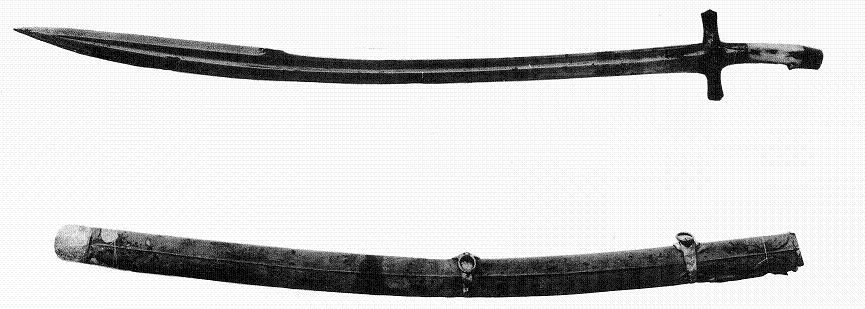 Kilic from the 15th century, no indication as to early or late:  Kilic from the 15th century, no indication as to early or late: 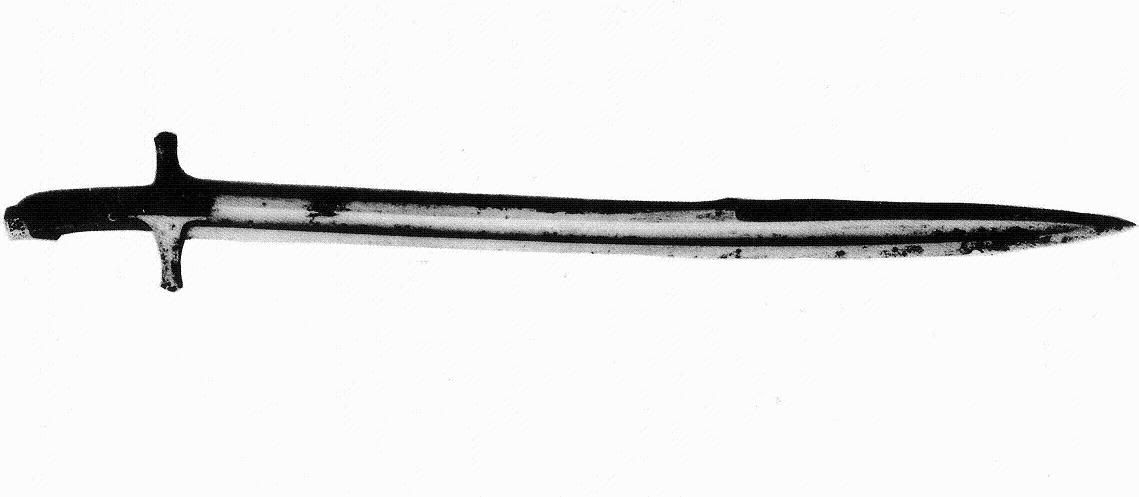 So, given that evidence, it would seem clear to me that the kilic with the yelman began springing up in the Mamluk Sultanate at the same time as the Ottoman Empire. With the exception of the lone curved sword Yucel dates to the 13th century, there is absolutely no evidence that the Mamluks developed the kilic, or that they were the first to come up with a yelman. Furthermore, such a theory wouldn't make much sense, as the Mamluks themselves came from many of the same Turkic regions where the Ottomans had lived before moving to Anatolia. Therefore, they would have access to the same weapons technology from that region. |
|
|
|

|
|
|
#6 |
|
Member
Join Date: Jun 2006
Location: Arabia
Posts: 278
|
Hello Alina!
 Very nice to see you here, how is it going with your kilij? Very nice to see you here, how is it going with your kilij?
|
|
|

|
|
|
#7 | |
|
Member
Join Date: Mar 2007
Location: California
Posts: 7
|
Quote:
 On the bright side, I chose to have Bayezid-i-sani's kilic copied and it's still my favorite even 18 months later. So, I guess I just have to keep waiting. On the bright side, I chose to have Bayezid-i-sani's kilic copied and it's still my favorite even 18 months later. So, I guess I just have to keep waiting.
|
|
|
|

|
|
|
#8 |
|
Member
Join Date: Mar 2007
Location: California
Posts: 7
|
To propose my own theory for the development of the kilic, I think it came from the Mongols, through the Persians, and then on to the Ottomans and Mamluks. Here are a couple of miniatures which support this view.
14th century Mongol painting. The man's sword is a bit tough to see, but note the yelman: 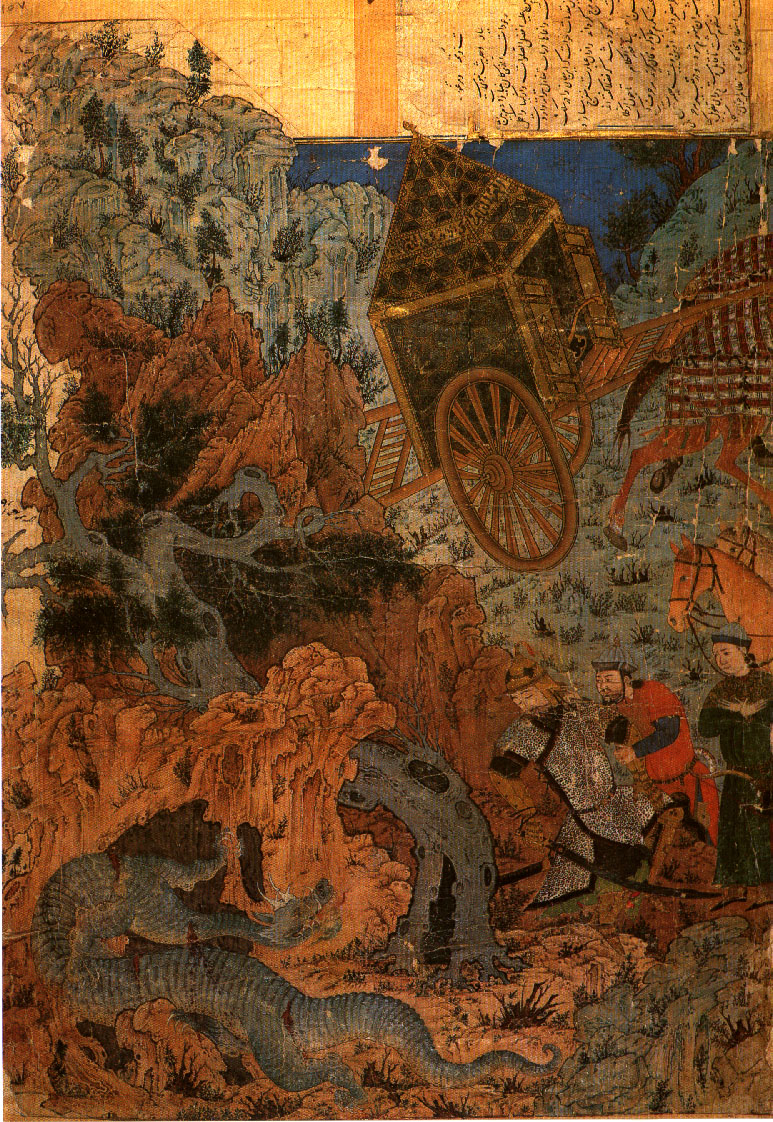 14th century Persian battle scene. Note the very bottom of the image, there is a curved sword with a yelman: 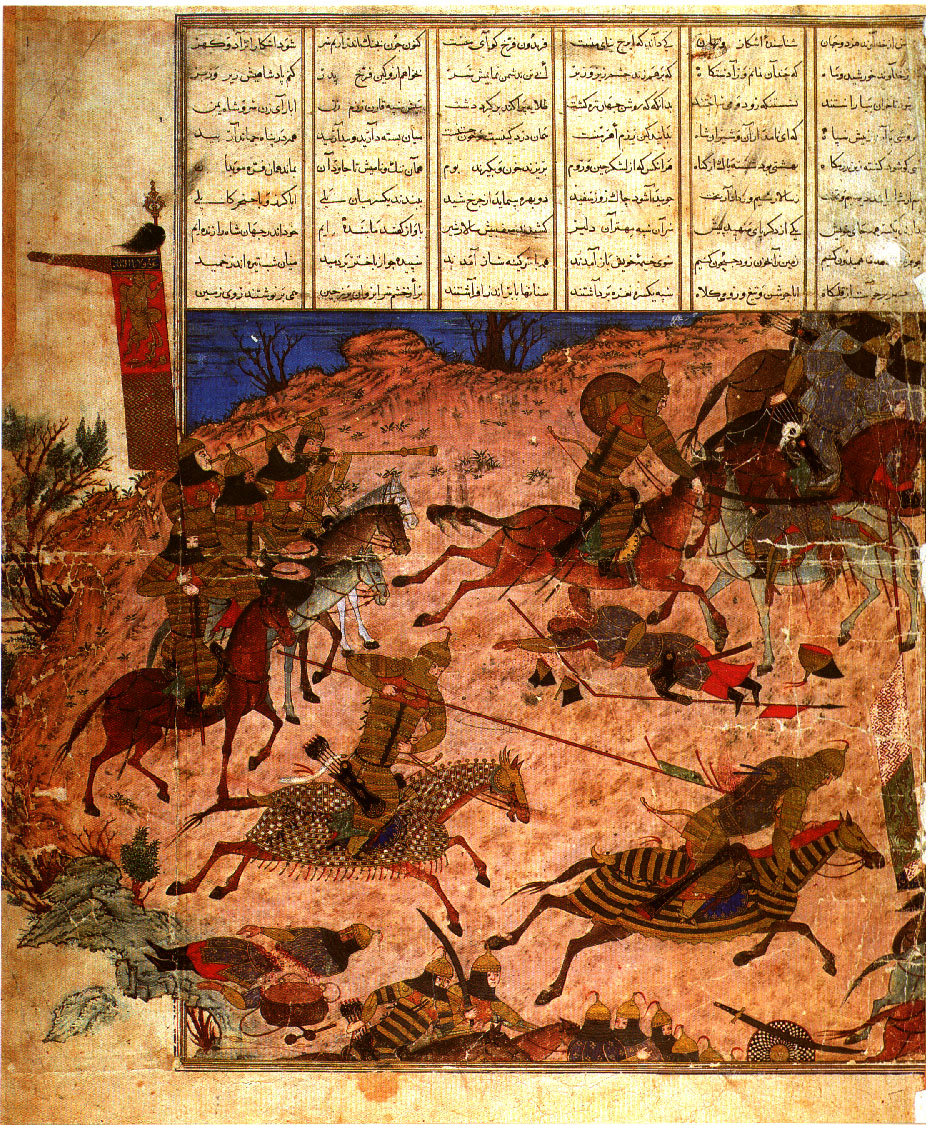 Persian battle scene from 1314. Note the curved sword, but without a yelman this time: 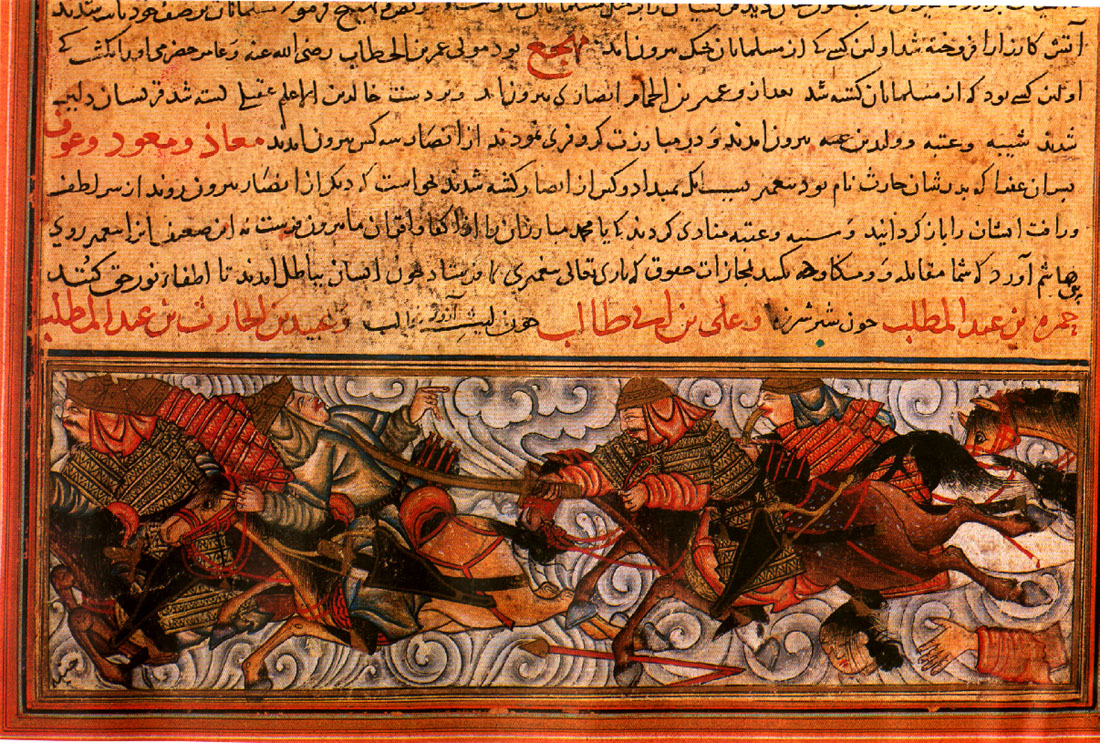
|
|
|

|
|
|
#9 |
|
Member
Join Date: Dec 2004
Location: Ann Arbor, MI
Posts: 5,503
|
Well, these are are pictures of either Monghols or the Persians fighting the Monghol-related warriors, and the Yelman-bearing swords do not belong to Persians, do they?
In his monumental treatise"Arms and Armor from Iran", Mr. Khorasani presented all kinds of swords he considered Persian (throwing in some Uzbeki and Indian stuff for good measure), but even he did not claim the Persian origin for any of the early Yelman swords. There is such thing as Indian Gaddara ( with Yelman), but all I have seen are ~18- 19th century. The swords you showed earlier are mostly Mameluke ( which was my point). We have no idea whether there were any Ottoman Yelman-bearing Kilijes ( Yusel must have known what he was talking about  ), but as you have noticed there were examples of similar Mameluke swords even in the 13th century. ), but as you have noticed there were examples of similar Mameluke swords even in the 13th century.Likely, the Yelman-ed swords originated in China or Central Asia, but they surely did not have any influence on Persian weapons and unlikely to pass down the "Persian route". In the absense of the Ottoman evidence, one wonders whether Yelman-ed swords found their way to the Mamelukes from Central Asia along the westward route, ie with the Kipchaks who formed the bulk of the Mameluke army. |
|
|

|
|
|
#10 | |
|
Member
Join Date: Mar 2007
Location: California
Posts: 7
|
Quote:
Alina |
|
|
|

|
|
|
#11 |
|
Member
Join Date: Dec 2004
Location: Ann Arbor, MI
Posts: 5,503
|
Dear Alina,
The Ottoman swords you posted are all from 15th century. Mameluke Yelman-ed swords date to earlier times. As I said, since we have no evidence of Ottoman Yelman-ed swords before the 15th century, we have no way of knowing whether they had them simultaneously with Mamelukes.As to your denial that you provided any example of a Mameluke Yelman-ed sword of 13th century, please look back at your earlier post mentioning Yusel's sword #37, belonging to Husam al-Din Lajin (1297-1299) and made by al-Ustad al-Halabi ( "of Aleppo", which is in modern Syria). As to the Persian origin of Kilij, please be kind enough and provide pictures of authentic Persian Kilijes with Yelmans dating to... what? ... 12-13th century? Earlier? That will surely prove your point that Persia might have been the conduit of Yelman's transfer to Turkey and Egypt. I shall be very grateful for the opportunity to learn something new. Best wishes. |
|
|

|
|
|
#12 | |
|
Member
Join Date: Dec 2004
Location: B.C. Canada
Posts: 473
|
Quote:
Thank you for bringing up this subject as it is a topic I have been meaning to look at for some time, but have never gotten around to it. I have believed like Alina, that the Ottoman kilij was a descendant of a Mongol predecessor, through Persia. You have previously mentioned (somewhere?) that in Manoucher's work that there is a missing link between the straight sword and the classic shamshir. I believe (and have yet to prove this) that it is the qalachuri. Unfortunately Manoucher is unclear on this style and tends to refer to it as a Persian name for the Ottoman Kilij. In Discussions with Philip He has pointed out to me that the art work shows the qalachuri predates the kilij as can be seen in Fig 28 of Orez Perski Persian Arms and Armour . I would love to hear more on this topic, as your discussions so far have given me a few good tips where to start reading more on this topic. Thanks again Jeff |
|
|
|

|
|
|
#13 | |
|
Member
Join Date: Mar 2007
Location: California
Posts: 7
|
Quote:
As to the Persian sources, I don't have any images of Persian swords with yelmans at the moment. Persian arms and armor have always taken a back seat to Ottoman arms and armor for me. However, just because I don't have them doesn't mean they don't exist. They certainly show up in the art of the period, as I've shown. David Nicolle's book "Arms and Armor of the Crusading Era" lists two 14th century Persian kilics with yelmans. But he admits that it's very difficult to date such weapons, and that they could be as late as the 15th or 16th centuries. Given all of those difficulties, I think that we have to go with the preponderance of the evidence. The preponderance of the evidence shows that the kilic began appearing in the 15th century in both the Ottoman and Mamluk sultanates roughly simultaneously. |
|
|
|

|
|
|
#14 | |
|
Member
Join Date: Dec 2004
Location: Ann Arbor, MI
Posts: 5,503
|
Quote:
 Thus, we have no idea what it looked like in reality. I checked Orez Perski, and the only Yelman-ed Persian sword there in Fig 140A, but it is dated 1884. Another ( Fig. 153), with a very rudimentary Yelman, may or may not have Persian blade, and is also attributed to 17th century. Thus, we have no idea what it looked like in reality. I checked Orez Perski, and the only Yelman-ed Persian sword there in Fig 140A, but it is dated 1884. Another ( Fig. 153), with a very rudimentary Yelman, may or may not have Persian blade, and is also attributed to 17th century.The question that nagged me for a long time is why did Qaachuri disappear without a trace? This would be the only such example (AFAIK), with the exception of the Excalibur. Perhaps, we do see a lot of them, but just do not recognize them as such because they do not conform to our idea what Qalachuri should look like. For all we know, the Moghuls might have called Qalachuri a sword with a shorter or a wider blade, or a one with two wide fullers and one narrow , or something like that. The bottom line, until we figure out what precisely is the construction of Qalachuri , any assignation of the " missing link" to it would be premature. Moreover, any definition of a yelman-ed sword as being Qalachuri absolutely requires its dating to very early time, because from the ~ 16th century, Ottoman influence was rather strong in the area. I have 3 Yelman-ed swords of non-Ottoman origin: an Afghani pseudoshashka, an Afghani short Pala-like sword and an Indo-Persian Gaddara (very similar to the example in Pant's book), but all are ~18-19th century. No help here. I have never seen or heard of an early truly Persian sword with Yelman earlier than 17th century or thereabouts. We just have to assume that Persians got a curved saber from the Steppes but not a Yelman-ed one. It is exactly the absense of Yelman-ed swords of Persian provenance that makes me believe that they were not the right conduit ( kind of the dog that did not bark  ). If so, Yelmans must have come to Egypt first, also from the Steppes but by a western route. Of course, should any contemporaneous (13th century or earlier) Yelman-ed swords of Ottoman origin are found, we will have to assume that both Ottomans and Mamelukes got them independently and from a common source. But it is unlikely to be from Persia. ). If so, Yelmans must have come to Egypt first, also from the Steppes but by a western route. Of course, should any contemporaneous (13th century or earlier) Yelman-ed swords of Ottoman origin are found, we will have to assume that both Ottomans and Mamelukes got them independently and from a common source. But it is unlikely to be from Persia.That way of thinking is also helpful in discussing the origin of Qame and Qaddare. If one assumes their orgination in Iran, they would be expected to migrate both to the east and to the west of their epicenter. However, we see them almost exclusively westward of Iran, not in Afghanistan, Uzbekistan or India. This suggest that they originated west of Persia, ie in the Caucasus and that Iran was the eastern-most limit of their migration. Caucasians brought them to the Ottoman Empire and its environs ( Bulgaria, Balkans for example and, partly, Arabia proper) and Mameluke-dominated areas (Egypt, Sudan, Syria). Indeed, even the very name of Qame is Circassian. But their spread petered out east of Iran. A new theory of weapons: the sword that was not there 
Last edited by ariel; 16th March 2007 at 06:01 AM. |
|
|
|

|
|
|
#15 | |
|
Member
Join Date: Dec 2004
Location: Ann Arbor, MI
Posts: 5,503
|
Quote:
First, I am glad you agree that your earlier statement re. Sword #37 was in fact incorrect: otherwise, you would be arguing with yourself. Second, your rather cavalier dismissal of Yusel's conclusions and dating is ... just cavalier. After all, he spent years studying these swords, whereas your only experience with them is limited to looking at the photographs in his book. This may be permissible if the error is blatant, but the intricacies of dating is not something that can be solved by a cursory glance. I agree with you that there are many difficulties in studying the origin of different weapons and the preponderance of evidence is sometimes the best we can do. However, there is no preponderance of evidence for your case (Persian origin of Kilijes); in fact, you have no evidence at all. Until and unless you can show us an example of a Persian Kilij pre-dating the Mameluke ( and later Ottoman) examples, this is just a proclamation, but not a proof. |
|
|
|

|
|
|
#16 | |
|
Member
Join Date: Mar 2007
Location: California
Posts: 7
|
Quote:
|
|
|
|

|
|
|
#17 |
|
Member
Join Date: Dec 2004
Location: B.C. Canada
Posts: 473
|
Thanks Ariel for the great response. I am going to be away for the next week and will try to come up with as well a thought out rebuttal (if I can).
All the best Jeff |
|
|

|
|
|
#18 | |
|
Member
Join Date: Dec 2004
Location: Ann Arbor, MI
Posts: 5,503
|
Quote:
Unfortunately, the material is so scarce that we ( myself first and foremost) invent more theories than solid answers... I'd love to see an old sword engraved " Qalachuri. Made in 1123"   Fat chance. More likely it will be chemically etched "Made in India" all over the nickelplating... Fat chance. More likely it will be chemically etched "Made in India" all over the nickelplating...  Have a safe trip! |
|
|
|

|
|
|
#19 |
|
Member
Join Date: May 2007
Posts: 8
|
Dear Ariel,
The correct Turkish word is "Karaçori" and it was an export item during the Göktürk period (Z.V. Togan, 1946. Also, Manouchehr's book has a number of references to Persian manuscripts on the subject.) Having no survived copy of a sword that is at least 13 centuries old is not enough to call it the Unicorn of swords, I believe. Dear Alina, The same above source (Z.V. Togan) states that Mongols were not advanced blacksmiths; instead, they were buying "quality swords" from Göktürks first, and later from Uygurs. Therefore, Mongols cannot be the developer of the "Kılıç form" (by the way, "yalman" is not the correct word for the false edge, as literally "yalman" in Turkish means the cutting or penetrating part of a cutting or penetrating weapon. Hence, for example, lances also have "yalman"s). It might have come from the East, and Persia might have been on its route; but I believe that it is more logical to assume that (if not locally developed) it was developed by the Turkic people in Asian steppes, and came along with their migrations during the Mongol invasion period. With reference to your theory and the paintings; if they were buying swords from Turkic people, it is obvious that Mongols, too, were using swords of this form during the invasions. Last edited by Odevan; 29th May 2007 at 09:11 AM. |
|
|

|
|
|
#20 |
|
Member
Join Date: Dec 2004
Location: Ann Arbor, MI
Posts: 5,503
|
Thanks for the opinion.
By "unicorn" I meant ( and still do) exactly what you describe: multiple mentions of it but no actual evidence. here is a South Russian ( or North Caucasian, or Steppe, depending what you want to call the area ) sword: a typical "Kilij" http://cgi.ebay.com/Medieval-Kyivan-...QQcmdZViewItem There are quite a lot of similar examples in the museums. |
|
|

|
|
|
#21 |
|
Member
Join Date: May 2007
Posts: 8
|
Thanks for the link, it's really a nice find. However, for the 9th-10th century, it is not unusual at all; V.V. Arendt's work "Türkische Säbel aus den VIII. - IX. Jahrhunderten" (1935) focuses on this type, examines many survived examples in different museums, and concludes with a clear decision of Turkic origin.
And for the karaçori; 1. Having "multiple mentions of it but no actual evidence" doesn't always mean being mythical or fabled like "unicorn" and "Excalibur". However, if you think that the Royal Library of Alexandria is the unicorn of libraries, then I can understand that there is a conceptual difference between you and me. 2. We all may have a mistake when assuming that the karaçori is the name of a certain type of kılıç; instead, it may well be the generic name of Turkic swords in its time. Although literally means black, "kara" is an adjective which addresses to anything that is ordinary or common, or that belongs to common people. "Çori" is not used in the modern Turkish language, except it means knife in the slang of Istanbul streets..! Therefore, I always ask myself; can it have a generic meaning, just like what we mean when talking of a "European military sabre" today? (With reference to your earlier post; there is no sword engraved "European military sabre" on it, but we still classify them as such.) If this is the case, then the abovementioned work of Arendt has many examples of karaçori from the 8th century. |
|
|

|
|
|
#22 |
|
Member
Join Date: Dec 2004
Location: Ann Arbor, MI
Posts: 5,503
|
That is interesting! I never thought about phonetics. You may be absolutely right:" kalachoori" may not be a particular type of sword ( in the sense of shamshir, shashka, khanda etc), but a generic one, with an altered spelling on top to make our lives a bit more difficult
 . If this is the case we might have indeed seen a lot of "Kalachoories" without recognizing them as such. It was mentioned casually in so many sources, always with an implication that it was somewhat curved and had a yelman, but never with any definition or actual example. That's why I called it a "unicorn". I think your explanation may be the best one I've ever heard about the nature of this sword. . If this is the case we might have indeed seen a lot of "Kalachoories" without recognizing them as such. It was mentioned casually in so many sources, always with an implication that it was somewhat curved and had a yelman, but never with any definition or actual example. That's why I called it a "unicorn". I think your explanation may be the best one I've ever heard about the nature of this sword. The potential preservation of an ancient word in street slang is fascinating: low language may indeed preserve old words despite linguistic changes introduced over the centuries by the ruling class. As a quick example, one can refer to English: Saxons were defeated by the Normans. The former became peasants, whereas the latter became overlords. Saxons raised oxen, whereas Normans ate beef. I am unfamiliar with the book you mentioned: is it too big for scanning and posting here? Or, any source of acquiring it? Must be very informative. Thanks for your comments!!! Last edited by ariel; 29th May 2007 at 02:32 PM. |
|
|

|
|
|
#23 |
|
Member
Join Date: May 2007
Posts: 8
|
That work of Arendt was published in the "Archaeologica Hungarica", AN16, 1935. Scanning the article is not an option, but many of the university libraries should have a copy; I think you can easily find it in via ILL.
|
|
|

|
|
|
#24 | |
|
Member
Join Date: Dec 2004
Location: Ann Arbor, MI
Posts: 5,503
|
Quote:
" ... the treasure found inside the Kaaba which consisted of.... five swords imported from Kala, a small Bengali sea-port and sword manufacturing center in India" That brings the mysterious Kalachoori back where it allegedly came from. Is it possible that the word Cori ( sorry for the wrong C, couldn't find the correct font) comes from a proto-Turkic language? The best that comes to my mind is the Afghani Choora. Last edited by ariel; 10th September 2007 at 06:41 AM. |
|
|
|

|
|
|
#25 |
|
Member
Join Date: May 2007
Posts: 8
|
I asked that to Dr. Oztopcu, who is a lecturer at UCLA as a respected authority on Turkic languages. He says he doesn't know any Turkic word similiar to "çori". Instead, he connects the term "Karaçori" to the other menitoned sword type in the same context, "Bilgatekini". Just like the "Tekin" of the latter, he suggest that it may come from "Çor", which is a high social rank amongst the middle-Asian Turkic tribes.
As you might have known, Bilge Tekin is a Gaznavid Emperor. The suffix "-i" gives a relation, so, the word "Bilgatekini" means "of Bilge Tekin". Dr. Oztopcu suggests the same explanation for the word "Karaçori"; "Kara Çor" may be the name (or nickname, just like "the Dark Knight") of a once-famous person, and the word "Karaçori" then means "of Kara Çor", that is, "Kara Çor style" for our subject-matter. This is Dr. Oztopcu's approach. Unfortunately it just confuses me some more, because there is no mention of a person named "Kara Çor" in the known Turkic history. It seems like the whole area needs a lot deeper research. |
|
|

|
|
|
#26 |
|
Member
Join Date: Dec 2004
Location: Ann Arbor, MI
Posts: 5,503
|
Another possibility is an almost homophonic word " ghoracharra" ( sp.). They were irregular Afghani/Sikh/N.Indian cavalry.
According to Khorasani's book, Kalachurri ( or qalachurri) was also alternatively spelled " Garachurri" Rings the bell? Last edited by ariel; 14th September 2007 at 11:31 AM. |
|
|

|
 |
|
|